Choosing the Optimal Cloud Architecture for MetaSoft's Infrastructure
VerifiedAdded on 2023/06/04
|8
|1838
|120
Report
AI Summary
This report provides an analysis of cloud computing architectures, focusing on application, hybrid, and traditional architectures, to determine the most suitable option for MetaSoft. It defines each architecture, highlighting their characteristics, advantages, and disadvantages. The report advocates for a hybrid architecture for MetaSoft, citing its flexibility and technical control benefits, while also acknowledging security risks, integration complexity, cloud management challenges, and network design considerations. The document concludes by emphasizing the importance of careful network design and understanding application scalability requirements for successful hybrid cloud implementation. Desklib offers this assignment solution along with a wealth of other study resources, including past papers and solved assignments.
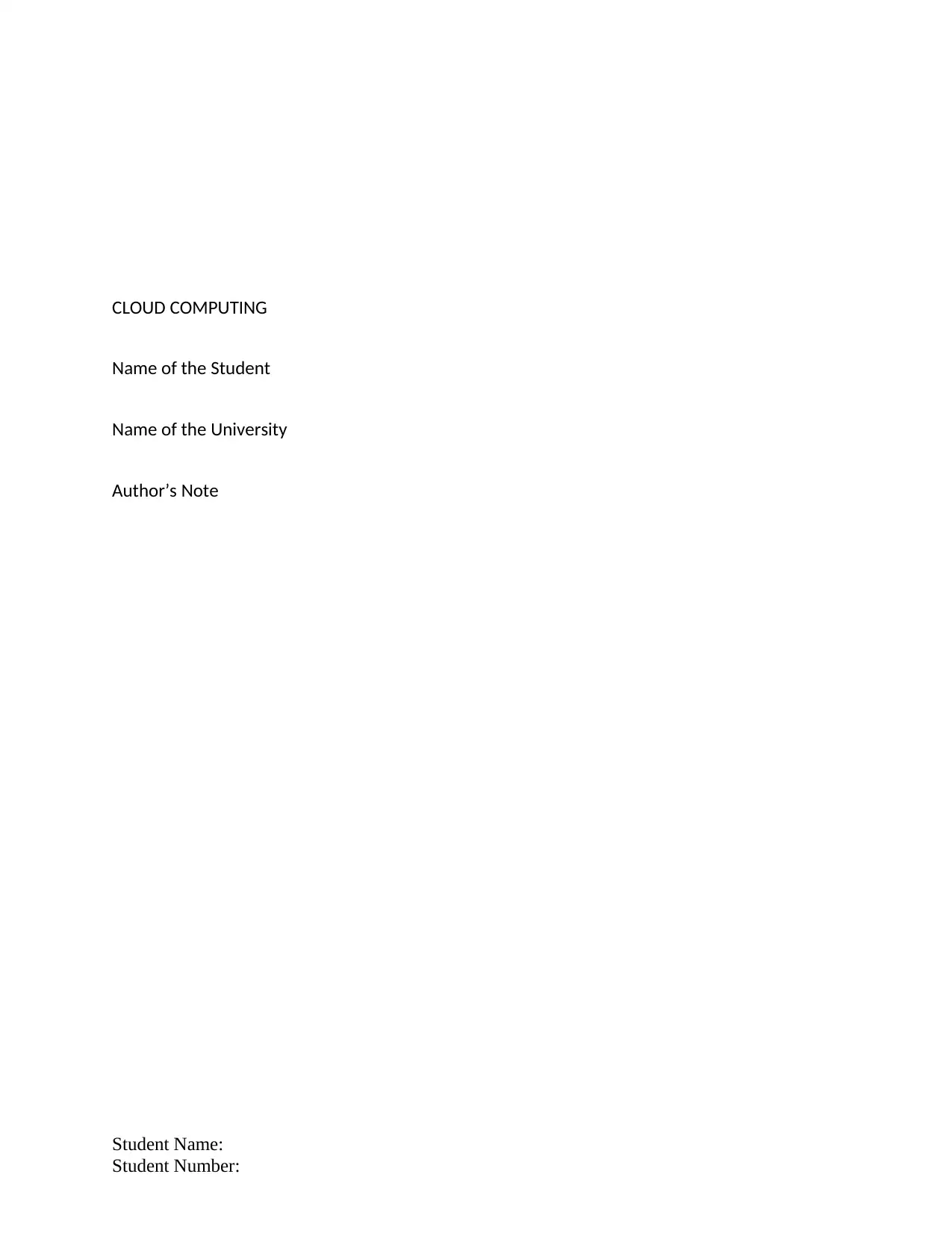
CLOUD COMPUTING
Name of the Student
Name of the University
Author’s Note
Student Name:
Student Number:
Name of the Student
Name of the University
Author’s Note
Student Name:
Student Number:
Paraphrase This Document
Need a fresh take? Get an instant paraphrase of this document with our AI Paraphraser
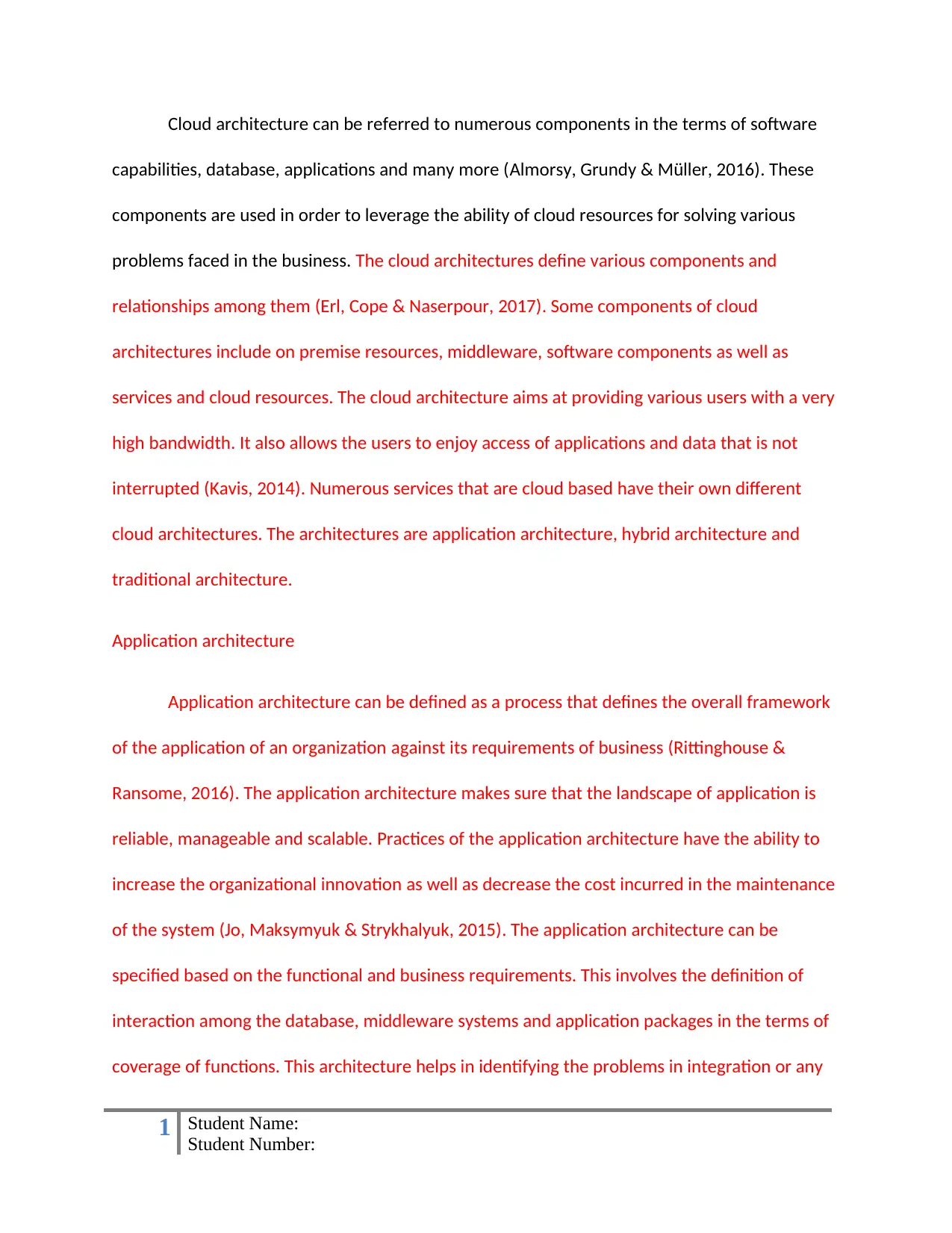
Cloud architecture can be referred to numerous components in the terms of software
capabilities, database, applications and many more (Almorsy, Grundy & Müller, 2016). These
components are used in order to leverage the ability of cloud resources for solving various
problems faced in the business. The cloud architectures define various components and
relationships among them (Erl, Cope & Naserpour, 2017). Some components of cloud
architectures include on premise resources, middleware, software components as well as
services and cloud resources. The cloud architecture aims at providing various users with a very
high bandwidth. It also allows the users to enjoy access of applications and data that is not
interrupted (Kavis, 2014). Numerous services that are cloud based have their own different
cloud architectures. The architectures are application architecture, hybrid architecture and
traditional architecture.
Application architecture
Application architecture can be defined as a process that defines the overall framework
of the application of an organization against its requirements of business (Rittinghouse &
Ransome, 2016). The application architecture makes sure that the landscape of application is
reliable, manageable and scalable. Practices of the application architecture have the ability to
increase the organizational innovation as well as decrease the cost incurred in the maintenance
of the system (Jo, Maksymyuk & Strykhalyuk, 2015). The application architecture can be
specified based on the functional and business requirements. This involves the definition of
interaction among the database, middleware systems and application packages in the terms of
coverage of functions. This architecture helps in identifying the problems in integration or any
1 Student Name:
Student Number:
capabilities, database, applications and many more (Almorsy, Grundy & Müller, 2016). These
components are used in order to leverage the ability of cloud resources for solving various
problems faced in the business. The cloud architectures define various components and
relationships among them (Erl, Cope & Naserpour, 2017). Some components of cloud
architectures include on premise resources, middleware, software components as well as
services and cloud resources. The cloud architecture aims at providing various users with a very
high bandwidth. It also allows the users to enjoy access of applications and data that is not
interrupted (Kavis, 2014). Numerous services that are cloud based have their own different
cloud architectures. The architectures are application architecture, hybrid architecture and
traditional architecture.
Application architecture
Application architecture can be defined as a process that defines the overall framework
of the application of an organization against its requirements of business (Rittinghouse &
Ransome, 2016). The application architecture makes sure that the landscape of application is
reliable, manageable and scalable. Practices of the application architecture have the ability to
increase the organizational innovation as well as decrease the cost incurred in the maintenance
of the system (Jo, Maksymyuk & Strykhalyuk, 2015). The application architecture can be
specified based on the functional and business requirements. This involves the definition of
interaction among the database, middleware systems and application packages in the terms of
coverage of functions. This architecture helps in identifying the problems in integration or any
1 Student Name:
Student Number:
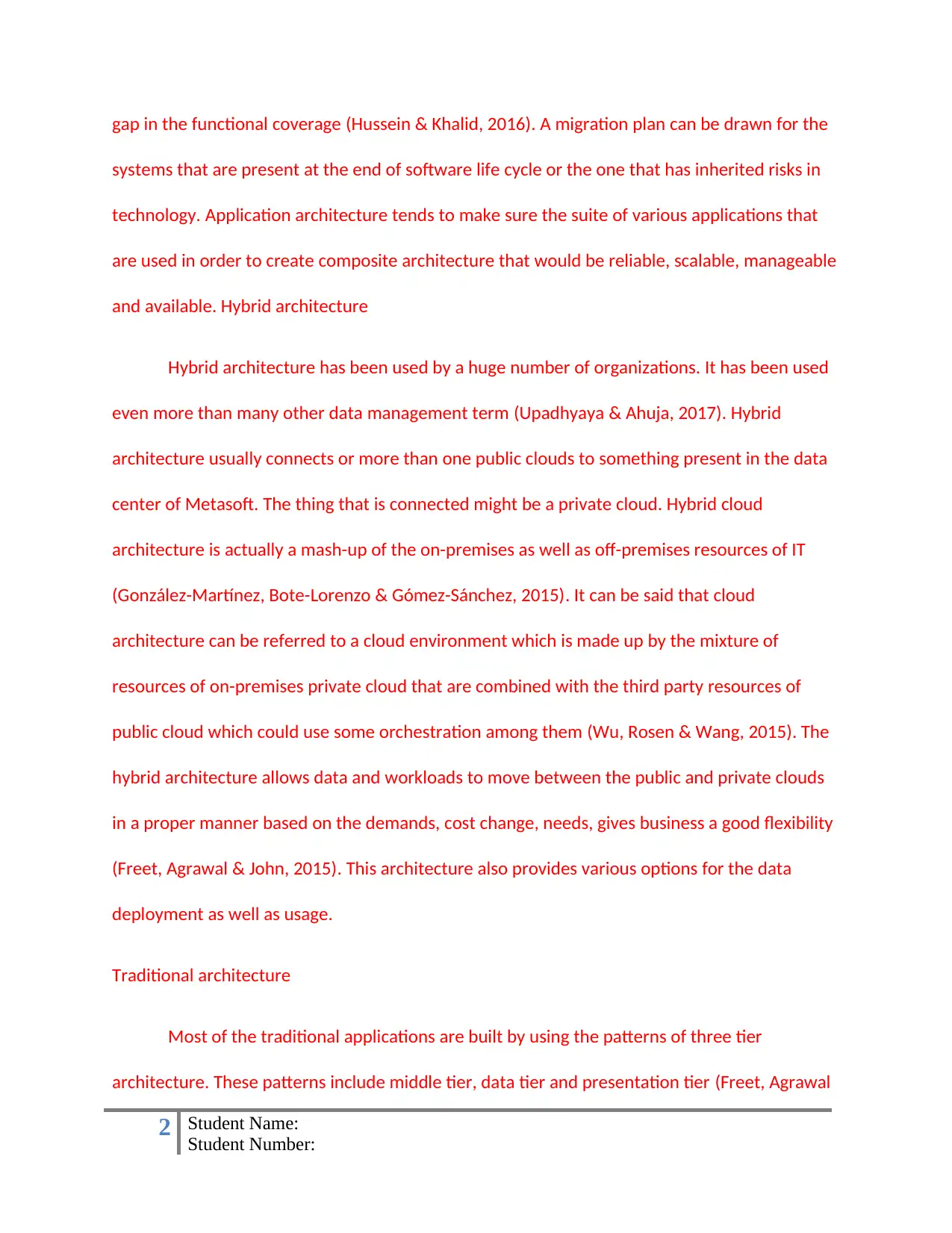
gap in the functional coverage (Hussein & Khalid, 2016). A migration plan can be drawn for the
systems that are present at the end of software life cycle or the one that has inherited risks in
technology. Application architecture tends to make sure the suite of various applications that
are used in order to create composite architecture that would be reliable, scalable, manageable
and available. Hybrid architecture
Hybrid architecture has been used by a huge number of organizations. It has been used
even more than many other data management term (Upadhyaya & Ahuja, 2017). Hybrid
architecture usually connects or more than one public clouds to something present in the data
center of Metasoft. The thing that is connected might be a private cloud. Hybrid cloud
architecture is actually a mash-up of the on-premises as well as off-premises resources of IT
(González-Martínez, Bote-Lorenzo & Gómez-Sánchez, 2015). It can be said that cloud
architecture can be referred to a cloud environment which is made up by the mixture of
resources of on-premises private cloud that are combined with the third party resources of
public cloud which could use some orchestration among them (Wu, Rosen & Wang, 2015). The
hybrid architecture allows data and workloads to move between the public and private clouds
in a proper manner based on the demands, cost change, needs, gives business a good flexibility
(Freet, Agrawal & John, 2015). This architecture also provides various options for the data
deployment as well as usage.
Traditional architecture
Most of the traditional applications are built by using the patterns of three tier
architecture. These patterns include middle tier, data tier and presentation tier (Freet, Agrawal
2 Student Name:
Student Number:
systems that are present at the end of software life cycle or the one that has inherited risks in
technology. Application architecture tends to make sure the suite of various applications that
are used in order to create composite architecture that would be reliable, scalable, manageable
and available. Hybrid architecture
Hybrid architecture has been used by a huge number of organizations. It has been used
even more than many other data management term (Upadhyaya & Ahuja, 2017). Hybrid
architecture usually connects or more than one public clouds to something present in the data
center of Metasoft. The thing that is connected might be a private cloud. Hybrid cloud
architecture is actually a mash-up of the on-premises as well as off-premises resources of IT
(González-Martínez, Bote-Lorenzo & Gómez-Sánchez, 2015). It can be said that cloud
architecture can be referred to a cloud environment which is made up by the mixture of
resources of on-premises private cloud that are combined with the third party resources of
public cloud which could use some orchestration among them (Wu, Rosen & Wang, 2015). The
hybrid architecture allows data and workloads to move between the public and private clouds
in a proper manner based on the demands, cost change, needs, gives business a good flexibility
(Freet, Agrawal & John, 2015). This architecture also provides various options for the data
deployment as well as usage.
Traditional architecture
Most of the traditional applications are built by using the patterns of three tier
architecture. These patterns include middle tier, data tier and presentation tier (Freet, Agrawal
2 Student Name:
Student Number:
⊘ This is a preview!⊘
Do you want full access?
Subscribe today to unlock all pages.

Trusted by 1+ million students worldwide
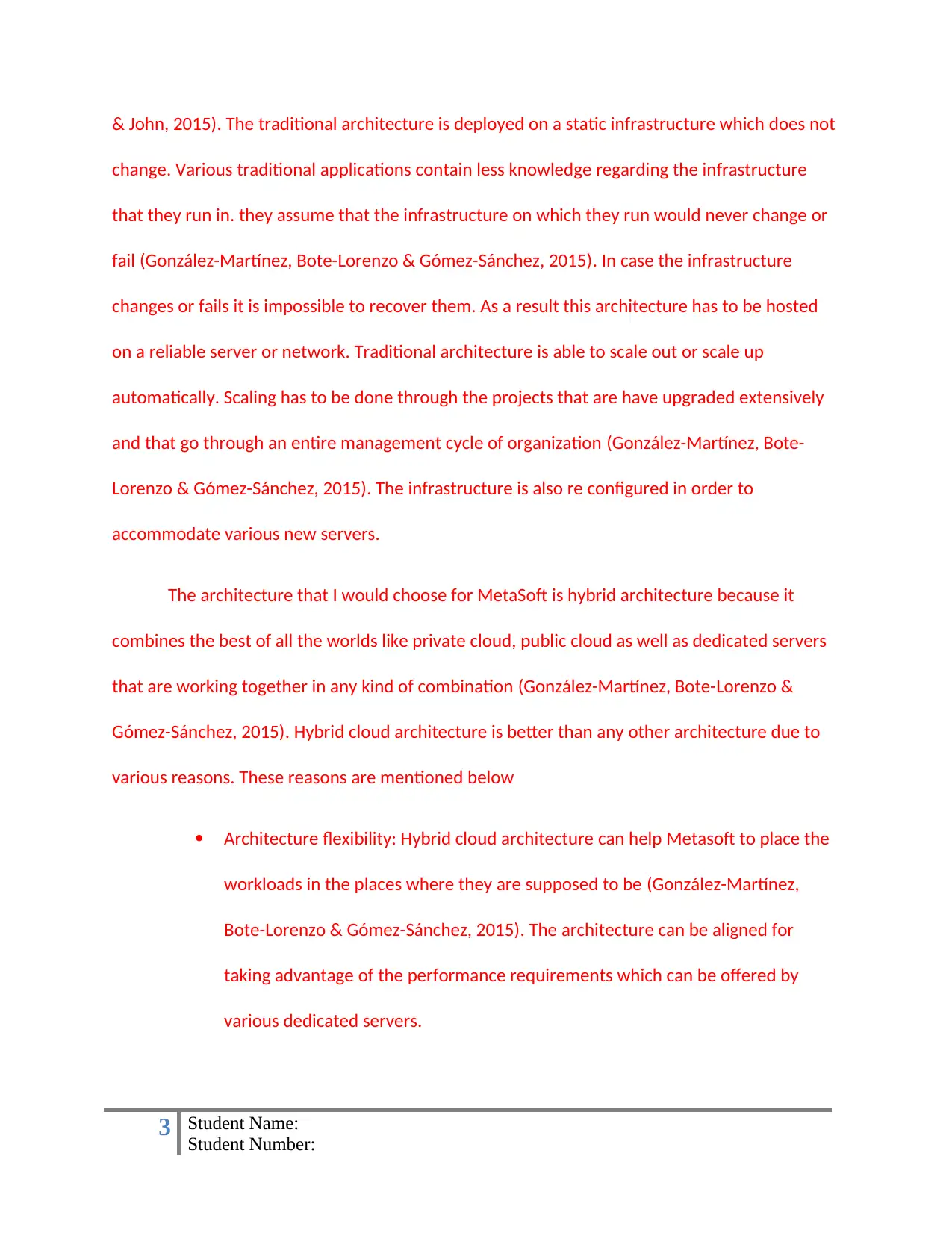
& John, 2015). The traditional architecture is deployed on a static infrastructure which does not
change. Various traditional applications contain less knowledge regarding the infrastructure
that they run in. they assume that the infrastructure on which they run would never change or
fail (González-Martínez, Bote-Lorenzo & Gómez-Sánchez, 2015). In case the infrastructure
changes or fails it is impossible to recover them. As a result this architecture has to be hosted
on a reliable server or network. Traditional architecture is able to scale out or scale up
automatically. Scaling has to be done through the projects that are have upgraded extensively
and that go through an entire management cycle of organization (González-Martínez, Bote-
Lorenzo & Gómez-Sánchez, 2015). The infrastructure is also re configured in order to
accommodate various new servers.
The architecture that I would choose for MetaSoft is hybrid architecture because it
combines the best of all the worlds like private cloud, public cloud as well as dedicated servers
that are working together in any kind of combination (González-Martínez, Bote-Lorenzo &
Gómez-Sánchez, 2015). Hybrid cloud architecture is better than any other architecture due to
various reasons. These reasons are mentioned below
Architecture flexibility: Hybrid cloud architecture can help Metasoft to place the
workloads in the places where they are supposed to be (González-Martínez,
Bote-Lorenzo & Gómez-Sánchez, 2015). The architecture can be aligned for
taking advantage of the performance requirements which can be offered by
various dedicated servers.
3 Student Name:
Student Number:
change. Various traditional applications contain less knowledge regarding the infrastructure
that they run in. they assume that the infrastructure on which they run would never change or
fail (González-Martínez, Bote-Lorenzo & Gómez-Sánchez, 2015). In case the infrastructure
changes or fails it is impossible to recover them. As a result this architecture has to be hosted
on a reliable server or network. Traditional architecture is able to scale out or scale up
automatically. Scaling has to be done through the projects that are have upgraded extensively
and that go through an entire management cycle of organization (González-Martínez, Bote-
Lorenzo & Gómez-Sánchez, 2015). The infrastructure is also re configured in order to
accommodate various new servers.
The architecture that I would choose for MetaSoft is hybrid architecture because it
combines the best of all the worlds like private cloud, public cloud as well as dedicated servers
that are working together in any kind of combination (González-Martínez, Bote-Lorenzo &
Gómez-Sánchez, 2015). Hybrid cloud architecture is better than any other architecture due to
various reasons. These reasons are mentioned below
Architecture flexibility: Hybrid cloud architecture can help Metasoft to place the
workloads in the places where they are supposed to be (González-Martínez,
Bote-Lorenzo & Gómez-Sánchez, 2015). The architecture can be aligned for
taking advantage of the performance requirements which can be offered by
various dedicated servers.
3 Student Name:
Student Number:
Paraphrase This Document
Need a fresh take? Get an instant paraphrase of this document with our AI Paraphraser
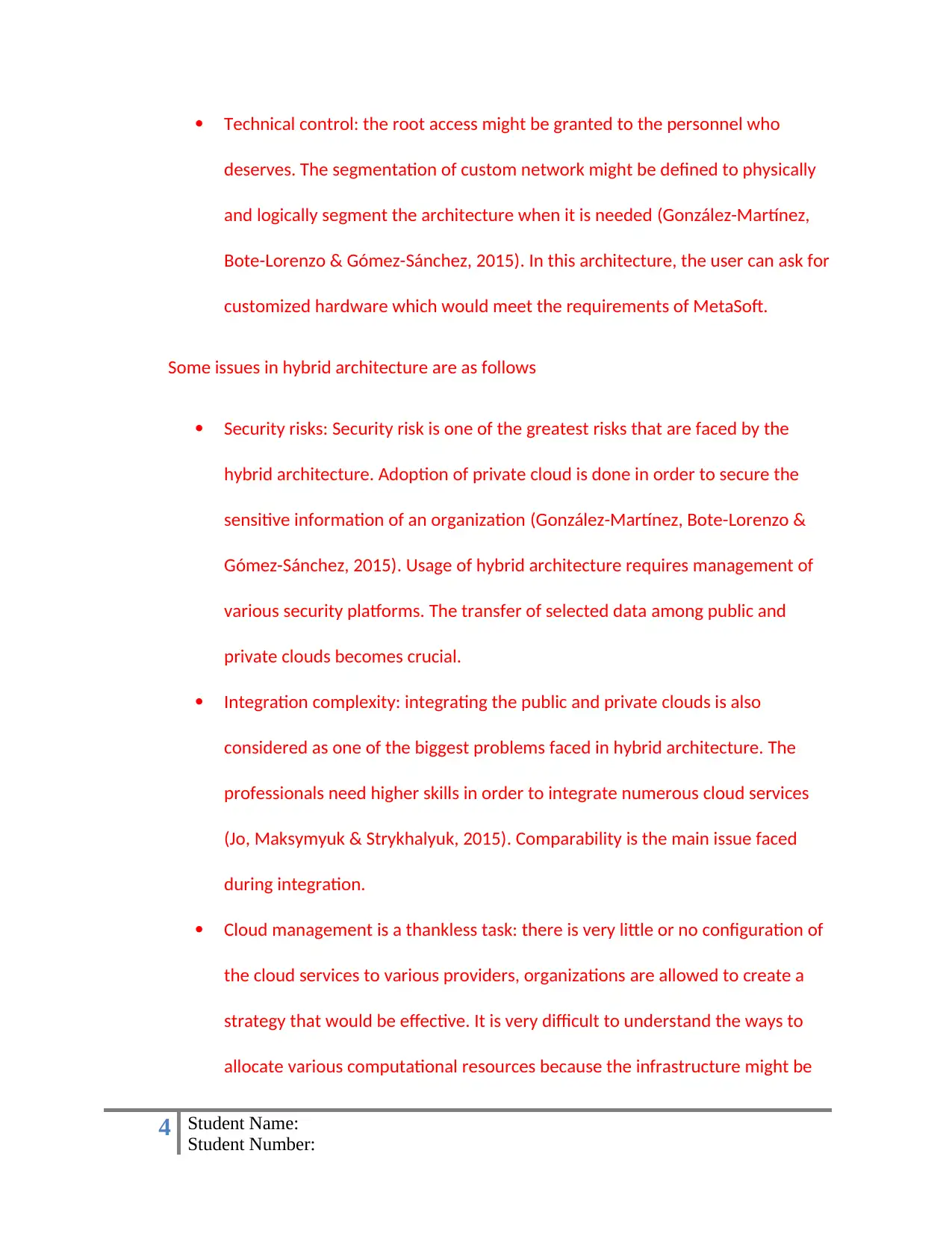
Technical control: the root access might be granted to the personnel who
deserves. The segmentation of custom network might be defined to physically
and logically segment the architecture when it is needed (González-Martínez,
Bote-Lorenzo & Gómez-Sánchez, 2015). In this architecture, the user can ask for
customized hardware which would meet the requirements of MetaSoft.
Some issues in hybrid architecture are as follows
Security risks: Security risk is one of the greatest risks that are faced by the
hybrid architecture. Adoption of private cloud is done in order to secure the
sensitive information of an organization (González-Martínez, Bote-Lorenzo &
Gómez-Sánchez, 2015). Usage of hybrid architecture requires management of
various security platforms. The transfer of selected data among public and
private clouds becomes crucial.
Integration complexity: integrating the public and private clouds is also
considered as one of the biggest problems faced in hybrid architecture. The
professionals need higher skills in order to integrate numerous cloud services
(Jo, Maksymyuk & Strykhalyuk, 2015). Comparability is the main issue faced
during integration.
Cloud management is a thankless task: there is very little or no configuration of
the cloud services to various providers, organizations are allowed to create a
strategy that would be effective. It is very difficult to understand the ways to
allocate various computational resources because the infrastructure might be
4 Student Name:
Student Number:
deserves. The segmentation of custom network might be defined to physically
and logically segment the architecture when it is needed (González-Martínez,
Bote-Lorenzo & Gómez-Sánchez, 2015). In this architecture, the user can ask for
customized hardware which would meet the requirements of MetaSoft.
Some issues in hybrid architecture are as follows
Security risks: Security risk is one of the greatest risks that are faced by the
hybrid architecture. Adoption of private cloud is done in order to secure the
sensitive information of an organization (González-Martínez, Bote-Lorenzo &
Gómez-Sánchez, 2015). Usage of hybrid architecture requires management of
various security platforms. The transfer of selected data among public and
private clouds becomes crucial.
Integration complexity: integrating the public and private clouds is also
considered as one of the biggest problems faced in hybrid architecture. The
professionals need higher skills in order to integrate numerous cloud services
(Jo, Maksymyuk & Strykhalyuk, 2015). Comparability is the main issue faced
during integration.
Cloud management is a thankless task: there is very little or no configuration of
the cloud services to various providers, organizations are allowed to create a
strategy that would be effective. It is very difficult to understand the ways to
allocate various computational resources because the infrastructure might be
4 Student Name:
Student Number:
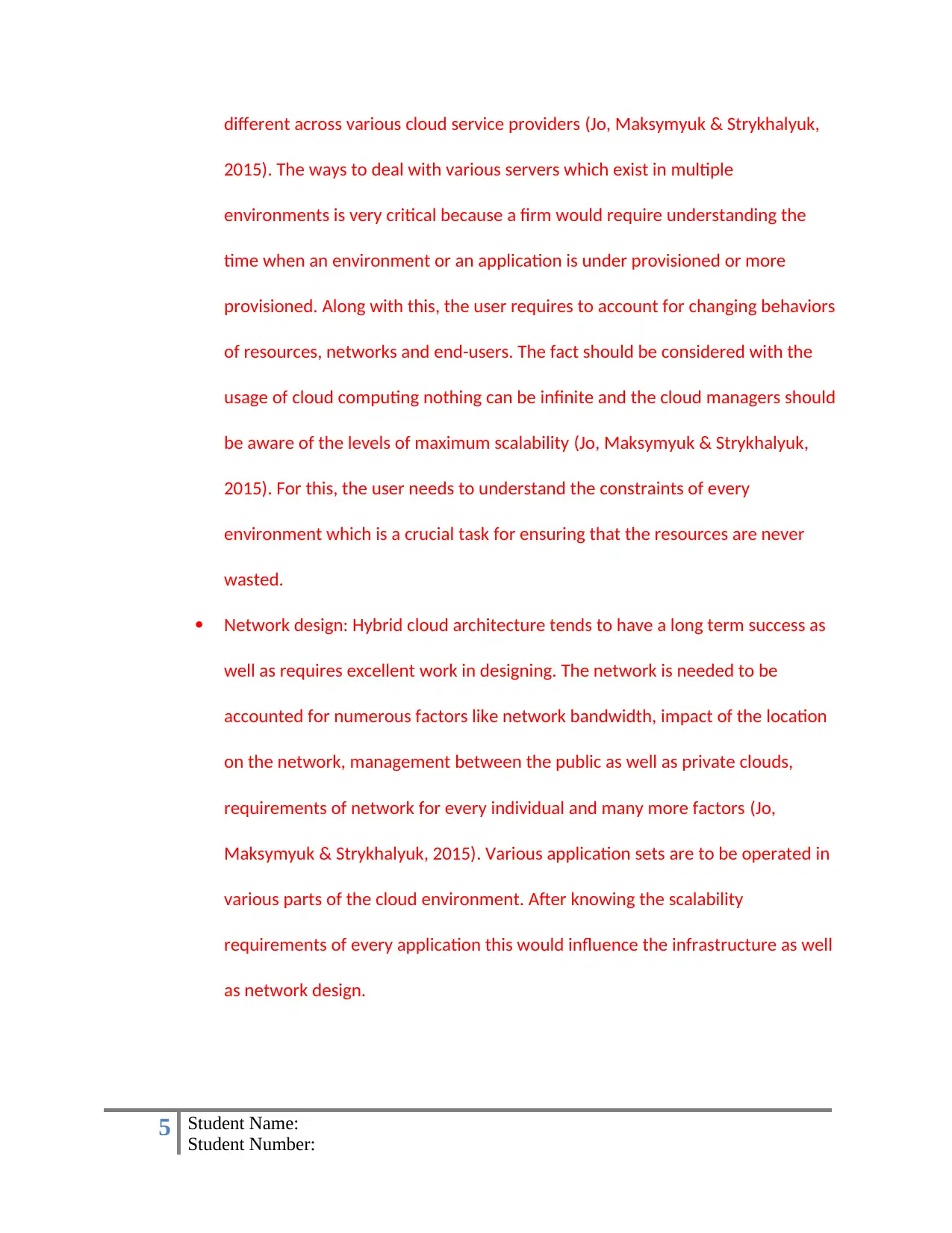
different across various cloud service providers (Jo, Maksymyuk & Strykhalyuk,
2015). The ways to deal with various servers which exist in multiple
environments is very critical because a firm would require understanding the
time when an environment or an application is under provisioned or more
provisioned. Along with this, the user requires to account for changing behaviors
of resources, networks and end-users. The fact should be considered with the
usage of cloud computing nothing can be infinite and the cloud managers should
be aware of the levels of maximum scalability (Jo, Maksymyuk & Strykhalyuk,
2015). For this, the user needs to understand the constraints of every
environment which is a crucial task for ensuring that the resources are never
wasted.
Network design: Hybrid cloud architecture tends to have a long term success as
well as requires excellent work in designing. The network is needed to be
accounted for numerous factors like network bandwidth, impact of the location
on the network, management between the public as well as private clouds,
requirements of network for every individual and many more factors (Jo,
Maksymyuk & Strykhalyuk, 2015). Various application sets are to be operated in
various parts of the cloud environment. After knowing the scalability
requirements of every application this would influence the infrastructure as well
as network design.
5 Student Name:
Student Number:
2015). The ways to deal with various servers which exist in multiple
environments is very critical because a firm would require understanding the
time when an environment or an application is under provisioned or more
provisioned. Along with this, the user requires to account for changing behaviors
of resources, networks and end-users. The fact should be considered with the
usage of cloud computing nothing can be infinite and the cloud managers should
be aware of the levels of maximum scalability (Jo, Maksymyuk & Strykhalyuk,
2015). For this, the user needs to understand the constraints of every
environment which is a crucial task for ensuring that the resources are never
wasted.
Network design: Hybrid cloud architecture tends to have a long term success as
well as requires excellent work in designing. The network is needed to be
accounted for numerous factors like network bandwidth, impact of the location
on the network, management between the public as well as private clouds,
requirements of network for every individual and many more factors (Jo,
Maksymyuk & Strykhalyuk, 2015). Various application sets are to be operated in
various parts of the cloud environment. After knowing the scalability
requirements of every application this would influence the infrastructure as well
as network design.
5 Student Name:
Student Number:
⊘ This is a preview!⊘
Do you want full access?
Subscribe today to unlock all pages.

Trusted by 1+ million students worldwide
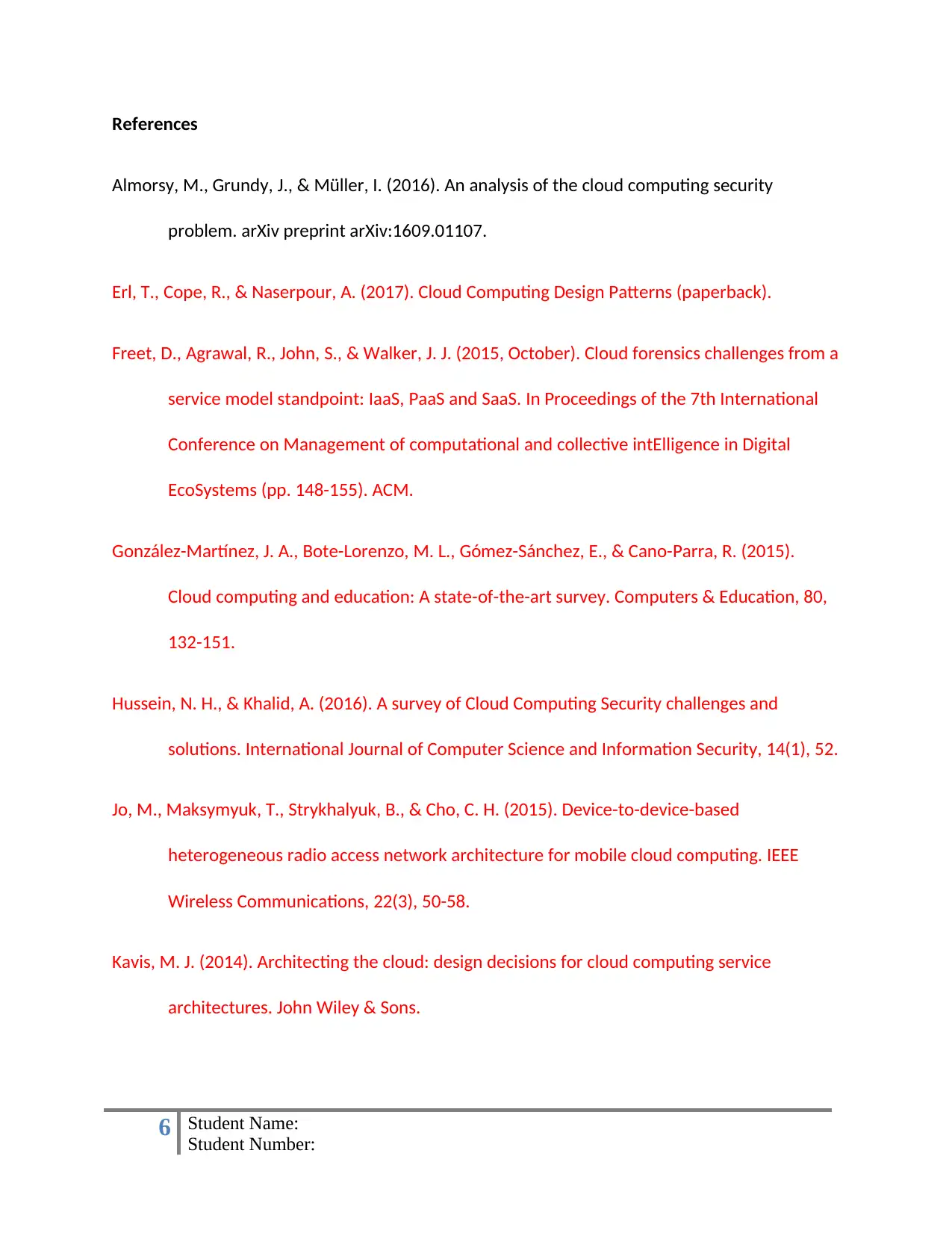
References
Almorsy, M., Grundy, J., & Müller, I. (2016). An analysis of the cloud computing security
problem. arXiv preprint arXiv:1609.01107.
Erl, T., Cope, R., & Naserpour, A. (2017). Cloud Computing Design Patterns (paperback).
Freet, D., Agrawal, R., John, S., & Walker, J. J. (2015, October). Cloud forensics challenges from a
service model standpoint: IaaS, PaaS and SaaS. In Proceedings of the 7th International
Conference on Management of computational and collective intElligence in Digital
EcoSystems (pp. 148-155). ACM.
González-Martínez, J. A., Bote-Lorenzo, M. L., Gómez-Sánchez, E., & Cano-Parra, R. (2015).
Cloud computing and education: A state-of-the-art survey. Computers & Education, 80,
132-151.
Hussein, N. H., & Khalid, A. (2016). A survey of Cloud Computing Security challenges and
solutions. International Journal of Computer Science and Information Security, 14(1), 52.
Jo, M., Maksymyuk, T., Strykhalyuk, B., & Cho, C. H. (2015). Device-to-device-based
heterogeneous radio access network architecture for mobile cloud computing. IEEE
Wireless Communications, 22(3), 50-58.
Kavis, M. J. (2014). Architecting the cloud: design decisions for cloud computing service
architectures. John Wiley & Sons.
6 Student Name:
Student Number:
Almorsy, M., Grundy, J., & Müller, I. (2016). An analysis of the cloud computing security
problem. arXiv preprint arXiv:1609.01107.
Erl, T., Cope, R., & Naserpour, A. (2017). Cloud Computing Design Patterns (paperback).
Freet, D., Agrawal, R., John, S., & Walker, J. J. (2015, October). Cloud forensics challenges from a
service model standpoint: IaaS, PaaS and SaaS. In Proceedings of the 7th International
Conference on Management of computational and collective intElligence in Digital
EcoSystems (pp. 148-155). ACM.
González-Martínez, J. A., Bote-Lorenzo, M. L., Gómez-Sánchez, E., & Cano-Parra, R. (2015).
Cloud computing and education: A state-of-the-art survey. Computers & Education, 80,
132-151.
Hussein, N. H., & Khalid, A. (2016). A survey of Cloud Computing Security challenges and
solutions. International Journal of Computer Science and Information Security, 14(1), 52.
Jo, M., Maksymyuk, T., Strykhalyuk, B., & Cho, C. H. (2015). Device-to-device-based
heterogeneous radio access network architecture for mobile cloud computing. IEEE
Wireless Communications, 22(3), 50-58.
Kavis, M. J. (2014). Architecting the cloud: design decisions for cloud computing service
architectures. John Wiley & Sons.
6 Student Name:
Student Number:
Paraphrase This Document
Need a fresh take? Get an instant paraphrase of this document with our AI Paraphraser
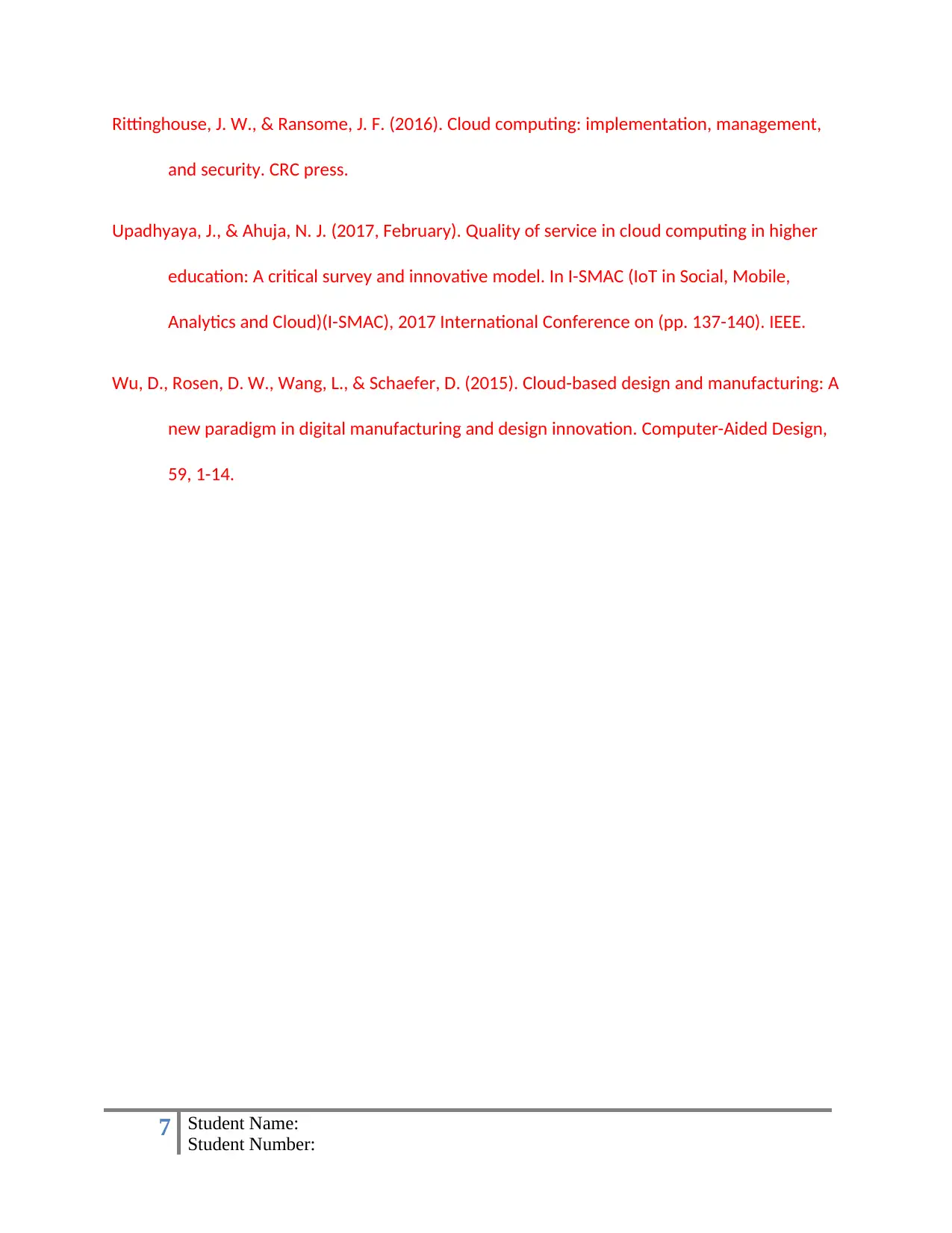
Rittinghouse, J. W., & Ransome, J. F. (2016). Cloud computing: implementation, management,
and security. CRC press.
Upadhyaya, J., & Ahuja, N. J. (2017, February). Quality of service in cloud computing in higher
education: A critical survey and innovative model. In I-SMAC (IoT in Social, Mobile,
Analytics and Cloud)(I-SMAC), 2017 International Conference on (pp. 137-140). IEEE.
Wu, D., Rosen, D. W., Wang, L., & Schaefer, D. (2015). Cloud-based design and manufacturing: A
new paradigm in digital manufacturing and design innovation. Computer-Aided Design,
59, 1-14.
7 Student Name:
Student Number:
and security. CRC press.
Upadhyaya, J., & Ahuja, N. J. (2017, February). Quality of service in cloud computing in higher
education: A critical survey and innovative model. In I-SMAC (IoT in Social, Mobile,
Analytics and Cloud)(I-SMAC), 2017 International Conference on (pp. 137-140). IEEE.
Wu, D., Rosen, D. W., Wang, L., & Schaefer, D. (2015). Cloud-based design and manufacturing: A
new paradigm in digital manufacturing and design innovation. Computer-Aided Design,
59, 1-14.
7 Student Name:
Student Number:
1 out of 8
Related Documents
Your All-in-One AI-Powered Toolkit for Academic Success.
+13062052269
info@desklib.com
Available 24*7 on WhatsApp / Email
![[object Object]](/_next/static/media/star-bottom.7253800d.svg)
Unlock your academic potential
Copyright © 2020–2025 A2Z Services. All Rights Reserved. Developed and managed by ZUCOL.




